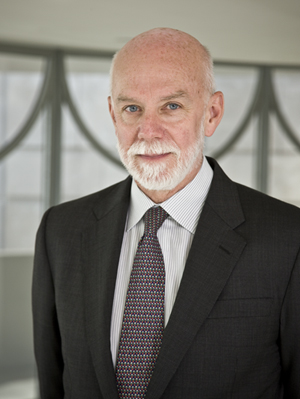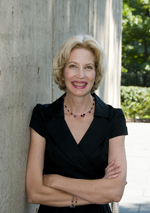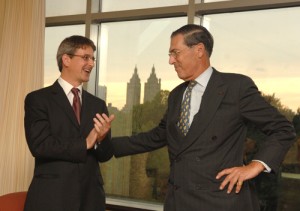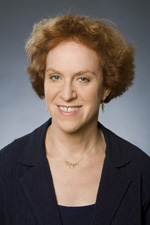CAA News Today
Svetlana Alpers Is CAA Distinguished Scholar
posted by Christopher Howard — November 10, 2008
The honoree of the 2009 Distinguished Scholar Session is Svetlana Alpers, a historian of seventeenth-century art and professor emerita of the University of California, Berkeley. Inaugurated in 2001, this Annual Conference session pays tribute to a renowned scholar who has made significant contributions to the field.
The Distinguished Scholar Session, entitled “Paintings/Problems/Possibilities” and chaired by Mariët Westermann of New York University, centers on the art of painting. The panel—which includes Alpers, Carol Armstrong of Yale University, Thomas Crow from New York University’s Institute of Fine Arts, the painter James Hyde, and Stephen Melville of Ohio State University—will focus on six pictorial images proposed by Alpers. The session takes place on Thursday, February 26, 2009, 2:30–5:00 PM, at the Los Angeles Convention Center, Room 502AB, Level 2.
After earning a BA from Radcliffe College in 1957, Alpers completed her doctorate in fine arts at Harvard University in 1965. She began teaching at the University of California, Berkeley, in the early sixties and remained there until her retirement in 1994.
Her books—among them The Art of Describing: Dutch Art in the Seventeenth Century (1983); Rembrandt’s Enterprise: The Studio and the Market (1988), which won CAA’s Charles Rufus Morey Book Award in 1990; and Tiepolo and the Pictorial Intelligence (1994), written with Michael Baxandall—have had an enormous impact on the discipline of art history. In 1983, Alpers founded the interdisciplinary journal Representations with Stephen Greenblatt; she remains a corresponding editor to this day.
An artist and a scholar, Alpers, together with James Hyde and the photographer Barney Kulok, recently completed a series of prints, Painting Then For Now. Fragments of Tiepolo at the Ca’ Dolfin, that is based on three paintings in the Metropolitan Museum of Art by the eighteenth-century Venetian artist Giambattista Tiepolo. An exhibition of these works was held at David Krut Projects in New York in 2007 and accompanied by a publication.
Alpers is CAA’s ninth distinguished scholar, joining a list of illustrious past honorees: Robert L. Herbert (2008), Linda Nochlin (2007), John Szarkowski (2006), Richard Brilliant (2005), James Cahill (2004), Phyllis Pray Bober (2003), Leo Steinberg (2002), and James Ackerman (2001).
Please read Mariët Westermann’s article on Svetlana Alpers and her accomplishments, which is also published in the November 2008 CAA News.
Leonardo López Luján Is Convocation Speaker
posted by Christopher Howard — November 04, 2008
 Leonardo López Luján, senior researcher and professor of archaeology at the Museo del Templo Mayor, Instituto Nacional de Antropología e Historia (INAH), in Mexico City, will deliver the keynote address during Convocation at the 2009 CAA Annual Conference in Los Angeles. Convocation takes place at the Los Angeles Convention Center on Wednesday evening, February 25, 5:30–7:00 PM.
Leonardo López Luján, senior researcher and professor of archaeology at the Museo del Templo Mayor, Instituto Nacional de Antropología e Historia (INAH), in Mexico City, will deliver the keynote address during Convocation at the 2009 CAA Annual Conference in Los Angeles. Convocation takes place at the Los Angeles Convention Center on Wednesday evening, February 25, 5:30–7:00 PM.
For nearly thirty years, López Luján has worked on the excavations of the Templo Mayor (Grand Temple), a fifteenth-century Aztec pyramid and its surroundings that are located in the heart of the Mexican capital; he has been director of the project since 1991. The temple lies beneath the Zócalo, also known as the Plaza de la Constitución, one of the largest public squares in the world. The project began when a monument to the Moon goddess Coyolxauhqui was found by electrical workers on the site of the old temple. During the last several years, other impressive monuments have been uncovered around the Great Temple of Tenochtitlan, among them the largest Aztec sculpture ever found, that of the Earth goddess Tlaltecuhtli.
In his talk, López Luján will focus on the most recent archaeological discoveries, while giving an overview of the history of archaeology in the Aztec capital. He will also discuss other topics, among them the recovery of the Tlaltecuhtli stone, an iconographic analysis that may unveil this sculpture’s functions and meanings, the rich offerings buried underneath it, and the possible presence of a royal tomb in this area of the sacred precinct.
Currently senior researcher at the Museo del Templo Mayor, where he has worked since 1988, López Luján is also senior professor at the Escuela Nacional de Antropología e Historia (ENAH) and the Escuela Nacional de Conservación, Restauración, y Museografía (ENCRyM) since 1987. He earned his doctorate in archaeology, with highest honors, at the Université de Paris-X in Nanterre in 1998. Before that he attended ENAH from 1983 to 1990, receiving a BA and MA—also with highest honors. López Luján was a fellow in Precolumbian studies in 2005–6 at Dumbarton Oaks in Washington, DC, and received a John S. Simon Guggenheim Fellowship in 2000. He has also taught and researched in Rome and Paris and at Princeton University.
López Luján has written and cowritten many books on the archaeology of Central Mexico. In The Offerings of the Templo Mayor of Tenochtitlan (originally published in Spanish in 1993; revised by the University of New Mexico Press in 2005), he presents the spectacular findings of Templo Mayor Project—masks, jewelry, skeletal remains of jaguars and alligators, statues of gods, precious stones, and human remains—from 1978 to 1997. The first English edition, published by the University Press of Colorado in 1994, was named Outstanding Academic Book by Choice and received the Eugene M. Kayden Humanities Award.
Mexico’s Indigenous Past, authored with Alfredo López Austin (1996; second English edition: University of Oklahoma Press, 2005), offers a panoramic view of the three super-areas of ancient Mexico—Mesoamerica, Aridamerica, and Oasisamerica—which stretched from present-day Costa Rica to what is now the southwestern United States. The book begins more than thirty thousand years ago and ends with European occupation in the sixteenth century.
With Davíd Carrasco and Eduardo Matos Moctezuma, he is most recently the author of Breaking through Mexico’s Past: Digging the Aztecs with Eduardo Matos Moctezuma (Albuquerque: University of New Mexico Press, 2007), an overview of their work on the Museo del Templo Mayor.
For more on López Luján and the Templo Mayor, please download Johanna Tuckman’s “In Search of an Aztec King” from the Summer 2008 issue of American Archaeology.
October Obituaries
posted by Christopher Howard — October 27, 2008
CAA recognizes the lives and careers of the following individuals in the arts, all of whom recently passed away.
- Albert Boime, an art historian and longtime professor at the University of California, Los Angeles, who researched the social history of art, died on October 18, 2008. He was 75
- Robert H. Chaney, a Houston business man who collected contemporary Asian and British art, died October 22, 2008
- Patricia Faure, a Los Angeles–based art dealer, died October 21, 2008, at the age of 80
- Jason Gleeson, an Australian artist and art critic who helped shape the collections of the National Gallery of Australia, died on October 20, 2008, a month shy of his 93rd birthday
- Ardeshir Mohasses, an Iranian-born political cartoonist and satirist whose work was the subject of a recent exhibition at the Asia Society in New York, died on October 9, 2008. He was 70
- Iba Ndiaye, a highly influential modern painter from Senegal who also lived and worked in Paris, died October 5, 2008, at the age of 80
- Paritosh Sen, a pioneering and well-known Indian artist, died October 22, 2008. He was 80.
Read all past obituaries in the arts on the CAA website.
Recent Deaths in the Arts
posted by Christopher Howard — October 01, 2008
CAA pays respect to the following artists, scholars, critics, and academics who recently passed away:
- Tina Allen, a sculptor of influential African Americans, died on September 9, 2008, at age 58
- Michael Baxandall, an art historian best known for transforming the methodologies of the discipline through his books, Giotto and the Orators (1971) and Painting and Experience in Fifteenth-Century Italy (1972), died on August 12, 2008, at the age of 74
- Dale Chisman, an abstract painter based in Denver, died on August 28, 2008. He was 65
- George Deem, a painter who cleverly reworked old-master paintings, died on August 11, 2008, at the age of 75
- Elizabeth Eames, a scholar of medieval tiles at the British Museum, died on September 20, 2008. She was 90
- Manny Farber, a painter and film critic whose writing had appeared since the early 1960s in the Nation, the New Republic, Film Comment, Film Culture, and Artforum, died on August 18, 2008. He was 91
- Marian Griffiths, a longtime director at Sculpture Center in New York, died September 8, 2008, at age 86
- Simon Hantaï, a reclusive French painter, died on September 11, 2008. He was 85
- France Alain Jacquet, a French painter associated with nouveau réalisme, died on September 4, 2008, at the age of 69
- Stephen A. Kliment, a former editor of the Architectural Record, died on September 10, 2008, at the age of 78
- Paul Overy, a British art critic, died on August 7, 2008, at age 68
- John Russell, a contributor of art criticism to the Sunday Times of London and chief art critic of the New York Times from 1982 to 1990, died on August 23, 2008. He was 89 years old
- Petrus Schaesberg, a scholar of modern and contemporary art and an adjunct professor at Columbia University, died on September 23, 2008. He was 40
- Stuart Cary Welch Jr., curator emeritus of Islamic and later Indian art at the Harvard Art Museum and and former special consultant in charge in the Department of Islamic Art at the Metropolitan Museum of Art, died on August 13, 2008. He was 80
- George Zarnecki, an expert on Romanesque art and a former director of the Courtauld Institute in London, died on September 8, 2008, a few days before his 93rd birthday
Read all past obituaries in the arts on the CAA website.
Richard Armstrong Succeeds Thomas Krens at Guggenheim
posted by Christopher Howard — September 24, 2008
 The Solomon R. Guggenheim Foundation has named Richard Armstrong to the position of director of the foundation, beginning November 4. He had served as Henry J. Heinz II Director of the Carnegie Museum of Art in Pittsburgh since 1996 before announcing his resignation in June. Armstrong succeeds Thomas Krens, who stepped down earlier this year. As director of both the foundation and its flagship museum in New York, Armstrong will focus on the pivotal role of that museum and its collection while also providing leadership and management for the three other Guggenheim institutions in Venice, Bilbao, and Berlin, as well as the Guggenheim Abu Dhabi Museum, scheduled to open in early 2013.
The Solomon R. Guggenheim Foundation has named Richard Armstrong to the position of director of the foundation, beginning November 4. He had served as Henry J. Heinz II Director of the Carnegie Museum of Art in Pittsburgh since 1996 before announcing his resignation in June. Armstrong succeeds Thomas Krens, who stepped down earlier this year. As director of both the foundation and its flagship museum in New York, Armstrong will focus on the pivotal role of that museum and its collection while also providing leadership and management for the three other Guggenheim institutions in Venice, Bilbao, and Berlin, as well as the Guggenheim Abu Dhabi Museum, scheduled to open in early 2013.
Photograph by David M. Heald and © Solomon R. Guggenheim Foundation
NEA Chairman Dana Gioia Resigns
posted by Christopher Howard — September 12, 2008
The National Endowment for the Arts announced today that Dana Gioia, chairman of the NEA since 2003, will leave his position in January 2009. He will return to writing, his primary occupation prior to leading the endowment. Gioia will also join the Aspen Institute on a half-time basis as the first director of the Harman/Eisner Program in the Arts.
Under Gioia’s leadership, the NEA has effectively democratized its programs and services, maintaining the highest artistic and educational standards and while achieving unprecedented outreach to millions of Americans. Gioia has also made arts education central to the agency’s mission, creating many programs that combine the presentation of arts with arts education to foster the next generation of artists, audiences and patrons.
Darsie Alexander Is Chief Curator at the Walker
posted by Christopher Howard — September 11, 2008
 The Star Tribune in Minneapolis–St. Paul recently reported that Darsie Alexander has been named chief curator at the Walker Art Center in Minnesota. Alexander, senior curator of contemporary art at the Baltimore Museum of Art in Maryland, starts her new position on November 10, replacing Philippe Vergne, who served as both the Walker’s deputy director and chief curator before he leaving last month to direct the Dia Art Foundation in New York.
The Star Tribune in Minneapolis–St. Paul recently reported that Darsie Alexander has been named chief curator at the Walker Art Center in Minnesota. Alexander, senior curator of contemporary art at the Baltimore Museum of Art in Maryland, starts her new position on November 10, replacing Philippe Vergne, who served as both the Walker’s deputy director and chief curator before he leaving last month to direct the Dia Art Foundation in New York.
Alexander’s recent exhibitions in Baltimore include SlideShow (2005) and Robert Motherwell: Meanings of Abstraction (2006). Two additional shows, Franz West, To Build a House You Start with the Roof: Work, 1972–2008, a retrospective of the Austrian sculptor’s work, and Front Room: Dieter Roth and Rachel Harrison, open next month.
Photograph by Mitro Hood and provided by the Walker Art Center.
Thomas P. Campbell to Direct the Metropolitan Museum of Art
posted by Christopher Howard — September 10, 2008
 The Metropolitan Museum of Art announced today that Thomas P. Campbell—an accomplished curator with a specialty in European tapestry who has worked at the museum since 1995—has been elected its next director and chief executive officer, succeeding Philippe de Montebello, who announced in January his intention to retire from the Metropolitan Museum at the end of this year.
The Metropolitan Museum of Art announced today that Thomas P. Campbell—an accomplished curator with a specialty in European tapestry who has worked at the museum since 1995—has been elected its next director and chief executive officer, succeeding Philippe de Montebello, who announced in January his intention to retire from the Metropolitan Museum at the end of this year.
Campbell organized the groundbreaking and widely acclaimed exhibitions Tapestry in the Renaissance: Art and Magnificence (2002), whose catalogue won CAA’s Alfred H. Barr, Jr., Award in 2003, and Tapestry in the Baroque: Threads of Splendor (2007). Currently curator in the Department of European Sculpture and Decorative Arts as well as supervising curator of the museum’s Antonio Ratti Textile Center, Campbell was elected at yesterday’s meeting of the board of trustees and will assume the directorship of the Metropolitan Museum on January 1, 2009.
Image: Thomas P. Campbell (left) and Philippe de Montebello (photograph by Don Pollard and provided by the Metropolitan Museum of Art)
Ann Temkin Named Chief Curator at MoMA
posted by Christopher Howard — September 03, 2008
The Museum of Modern Art in New York has announced that Ann Temkin will succeed John Elderfield as chief curator of painting and sculpture. Temkin, who served for thirteen years at the Philadephia Museum of Art in Pennsylvania, has been a curator at MoMA for five years. Among her exhibitions there are Color Chart: Reinventing Color, 1950 to Today (2008) and Against the Grain: Contemporary Art from the Edward R. Broida Collection (2006).
The New York Times has the story. Photograph by Robin Holland and provided by the Museum of Modern Art.
Women’s Caucus for Art Lifetime Achievement Awards
posted by Christopher Howard — August 27, 2008
The Women’s Caucus for Art (WCA) has selected five recipients for its 2009 Lifetime Achievement Awards:
- Maren Hassinger, director of the Rinehart School of Graduate Sculpture at the Maryland Institute College of Art
- Ester Hernandez, a San Francisco–based artist who was a pioneer in the Chicana/Chicano civil rights art movement
- Joyce Kozloff, a political and feminist artist who was a founding member of the Pattern and Decoration movement of the 1970s
- Margo Machida, a renowned authority on contemporary Asian American art and visual culture and associate professor at the University of Connecticut
- Ruth Weisberg, an artist and dean of fine arts at the University of Southern California
The awards ceremony will be held at the Wilshire Grand Hotel in Los Angeles on Saturday, February 28, 2009, in conjunction with the CAA Annual Conference. This ceremony, which is free and open to the public, will be the thirtieth anniversary of the awards. As in past years, the awards ceremony will include an accompanying catalogue, outlining the awardees’ accomplishments in greater detail. Please check the WCA website for more details about the ceremony (free), the awards dinner (tickets are $90 before December 1, 2008, and $105 after), and other planned events.




